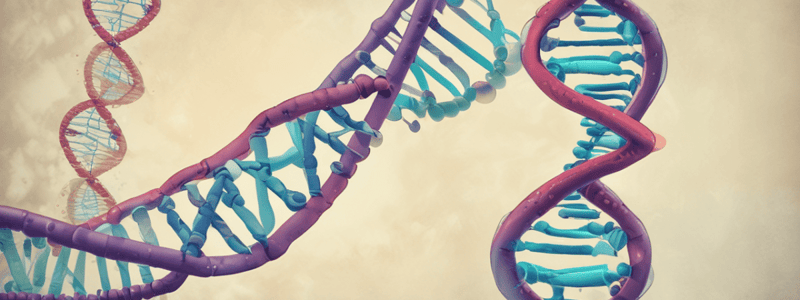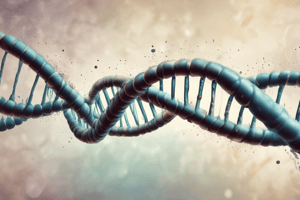Podcast
Questions and Answers
What is unique to prokaryotes but not eukaryotes?
What is unique to prokaryotes but not eukaryotes?
- simultaneous transcription and translation (correct)
- spliceosomes
- polyribosomes
- exons
Why is DNA replication considered semiconservative?
Why is DNA replication considered semiconservative?
- antisense, DNA
- codon, anticodon
- sense, mRNA
- template, final DNA (correct)
Why is Taq polymerase used in the polymerase chain reaction instead of DNA polymerase from E. coli?
Why is Taq polymerase used in the polymerase chain reaction instead of DNA polymerase from E. coli?
- can initiate DNA synthesis at a wider variety of sequences
- is easier to obtain
- is heat-stable (correct)
- can denature a double-stranded DNA template
- introduces fewer errors during DNA synthesis
What is the function of ligase?
What is the function of ligase?
Which enzyme is used to synthesize DNA in the polymerase chain reaction?
Which enzyme is used to synthesize DNA in the polymerase chain reaction?
Which enzyme is required for the joining of Okazaki fragments?
Which enzyme is required for the joining of Okazaki fragments?
What is the primary function of RNA splicing?
What is the primary function of RNA splicing?
Which enzyme initiates the synthesis of an RNA primer?
Which enzyme initiates the synthesis of an RNA primer?
Which process results in the transfer of DNA from one bacterium to another via a virus?
Which process results in the transfer of DNA from one bacterium to another via a virus?
In which phase of the cell cycle does DNA replication occur?
In which phase of the cell cycle does DNA replication occur?
Which enzyme is responsible for synthesizing new DNA strands during DNA replication?
Which enzyme is responsible for synthesizing new DNA strands during DNA replication?
Which feature is unique to eukaryotic mRNA processing?
Which feature is unique to eukaryotic mRNA processing?
Which of the following enzymes extends the RNA primer with DNA nucleotides?
Which of the following enzymes extends the RNA primer with DNA nucleotides?
Flashcards are hidden until you start studying
Study Notes
Prokaryotes vs Eukaryotes
- Prokaryotes have simultaneous transcription and translation, which is not found in eukaryotes.
- This means that in prokaryotes, the mRNA transcript is being translated into protein while it is still being transcribed from the DNA template.
DNA Replication
- DNA replication is considered semiconservative because it uses the template strands of DNA to synthesize new strands.
- This results in two new DNA molecules, each composed of one old strand (the template) and one new strand synthesized from the template.
Taq Polymerase
- Taq polymerase is used in PCR (Polymerase Chain Reaction) instead of DNA polymerase from E. coli because it is heat-stable.
- This allows it to withstand the high temperatures required for PCR, which would denature and inactivate E. coli DNA polymerase.
Ligase
- Ligase is an enzyme that rejoins segments of DNA.
- It is essential for DNA replication and repair, as it can seal gaps between Okazaki fragments and repair broken DNA strands.
mRNA Processing and DNA Replication
- mRNA processing involves several steps, including splicing, capping, polyadenylation, and transport.
- DNA replication involves the unwinding of DNA, synthesis of new DNA strands, and ligation.
Enzymes in DNA Replication
- DNA ligase is used to join nicks in the DNA strand.
- Helicase is used in the unwinding of DNA.
- Primase is not used to join nicks in the DNA strand, but rather to synthesize RNA primers.
- Endonuclease is not used to join nicks in the DNA strand.
Prokaryotes and Gene Expression
- Transcription, translation, and replication occur in prokaryotes.
- Splicing does not occur in prokaryotes.
- Mutation is necessary for the purpose of evolution.
- Replication is necessary for the survival of the cell.
- Translation is necessary for the synthesis of proteins.
- Transcription is necessary for the synthesis of RNA.
Gene Expression
- Transcription, RNA processing, and translation are all part of gene expression.
- Replication is not part of gene expression.
Constitutive and Inducible Enzymes
- Constitutive enzymes are always expressed and are necessary for the survival of the cell.
- Inducible enzymes are only expressed in response to a specific stimulus or signal.
Generalized and Specialized Transduction
- Generalized transduction involves the transfer of any gene from the donor cell to the recipient cell.
- Specialized transduction involves the transfer of a specific gene from the donor cell to the recipient cell.
Conjugation and DNA Transfer
- An F pilus is essential for plasmid transfer by conjugation.
- DNA transformation involves the transfer of DNA from one cell to another.
- Chromosome transfer by conjugation involves the transfer of the entire chromosome from the donor cell to the recipient cell.
Prokaryotes and Eukaryotes
- Polyribosomes are present in prokaryotes but not eukaryotes.
- Simultaneous transcription and translation occurs in prokaryotes.
- Exons are present in eukaryotes but not prokaryotes.
- Spliceosomes are present in eukaryotes but not prokaryotes.
Studying That Suits You
Use AI to generate personalized quizzes and flashcards to suit your learning preferences.




